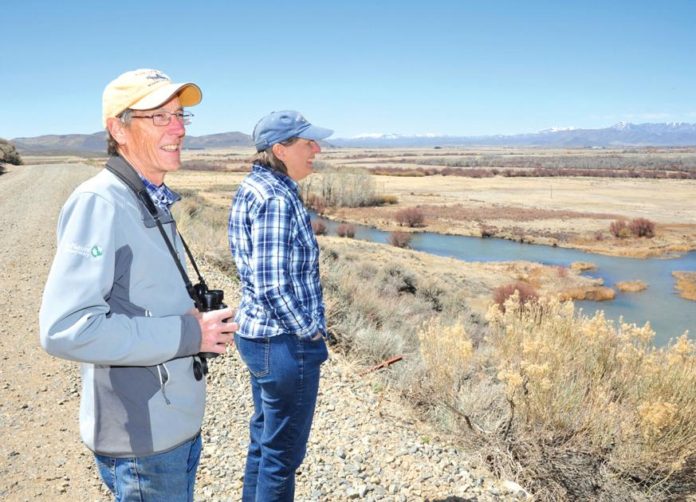The Nature Conservancy’s 881-acre Silver Creek Preserve near Picabo is a world-class fly-fishing destination and one of the most wildlife abundant areas in south Idaho.
Lou and Cindy Lunte recently returned to the preserve as managers after 33 years spent supporting environmental conservation for The Nature Conservancy in Idaho.
To the Luntes, Silver Creek is a shining example of how one pristine conservation area can serve as inspiration for surrounding landowners to pitch in for biodiversity.
“Silver Creek has one of the highest populations of fish in the U.S. because it also has one of the highest concentrations of insects,” said Cindy Lunte, who worked for 10 years as a land steward and director of science for the private nonprofit organization. Her husband, Lou, spent more than three decades serving TNC, including 12 years as its deputy director.
“The organization has changed a bit since 1988,” Lou said. “Back then, we had a staff of five or six. Today, Idaho TNC has about 26 staff and the organization is now worldwide with a staff of 3,500 to 4,000.”
The Luntes met in 1979 while working for the U.S. Forest Service in the Eagle Cap Wilderness in Oregon’s Wallowa Mountains. Cindy had grown up on a blueberry farm in view of Mount St. Helens in Camas, Wash. Lou, who graduated from the University of Idaho, grew up in St. Louis, Mo.
“In the Midwest there are very few public lands, so you couldn’t be spontaneous about an overnight camping trip,” Lou said.
The couple spent time studying in Madison, Wis., where Cindy earned a master’s degree in freshwater sciences. Lou, who had a bachelor’s degree in microbiology, was working in a laboratory there.
“I learned at that time that I didn’t want to be wearing a lab coat all week long,” he said.
In Madison, the Luntes met a person working for The Nature Conservancy and learned about the organization’s mission to engage donors and land conservationists to protect wild places from development. Soon they were off to Idaho to interview for a job at the Hemingway House in Ketchum—at that time an Idaho TNC office.
“I decided not to wear a tie for the interview but I did wear a sports coat,” Lou said. “Well, down the stairs comes Guy Bonnivier, the executive director, wearing shorts and no shirt, surrounded by his bounding dogs. That meeting set a casual tone for the job that lay ahead.”
The Luntes built a cabin for Idaho TNC at Silver Creek while managing a 200-acre alfalfa farm for a neighbor. Over the years, they travelled and worked as stewards at 18 Idaho TNC conservation areas, including Thousand Springs State Park near Hagerman, Garden Creek in Hells Canyon and the Flat Ranch near Yellowstone National Park.
Meanwhile, TNC’s practice of creating and purchasing conservation easements with willing landowners was becoming more widespread. This conservation tool establishes a value for the cost of keeping some options for environmentally sensitive properties off the table in perpetuity and often helps cover that cost. That could mean securing an agreement to not develop housing or other buildings, keeping agricultural practices away from riparian areas or limiting aerial spraying of insecticides. Most allow for continued uses, such as ranching, and allow for tax deductions in the form of donated conservation easements.
“Limiting housing developments is usually the most valuable portion of a conservation easement,” Lunte said. “But limiting aerial spraying is also very important here at Silver Creek. It is a windy place and the chemicals in those sprays can get into the water here and damage insect populations.”
A host of fish, bird and plant species rely on the bugs at Silver Creek. The area also is home to a thriving population of moose, elk, deer, bobcats and mountain lions. Cindy said thousands of visitors come each year, including anglers who time their visits to coincide with hatches of particular bugs.
“The brown Drake hatch in early May but the Tricos come off in massive numbers in mid-summer,” she said. “Hundreds of swallows come out for them and the fish go crazy.”
Those fish include the introduced rainbows and much larger brown trout, which regularly reach 30 inches in length.
“There was a time when people were less concerned about invasive species,” Lou said. “Brown trout were brought in from places with less optimal conditions at a time when Silver Creek was in a more degraded condition.”
Cindy said anglers going after the biggest brown trout use flies shaped like mice and voles, which sometime fall into the creek to become meals for the fish.
Since Idaho TNC bought Silver Creek from the Sun Valley Co. in 1976, the acreage has grown only slightly, but surrounding ranchers have contributed far more land in conservation easements to protect what are now crystal-clear waters.
“At first they were a little skeptical about what we were doing here,” Lou said. “But now there are more than 12,000 acres of conservation easements surrounding us. The Purdy family has contributed 3,000 acres. The family of John Stevenson, the Molyneuxs and others have also made a difference.”
Lou spent much of his career with Idaho TNC working with potential donors, including Kathy Troutman, who had worked on TNC’s volunteer board. Troutman wanted to help TNC and the state of Idaho preserve Box Canyon, an enourmous natural spring near the Snake River.
“Many conservation organizations and the state were fighting a proposed fish hatchery there,” Lou said. “But they didn’t have the money to preserve it.”
Troutman did. Lou said he met her about setting it aside as a conservation area after hearing that she was willing to help.
“She handed me a $1 million check in a Ketchum coffee shop. Nothing like that had ever happened to me before,” he said.
Box Canyon, which flows from an underground spring through a pristine canyon of waterfalls, is now a state park.
Credit: Source link































